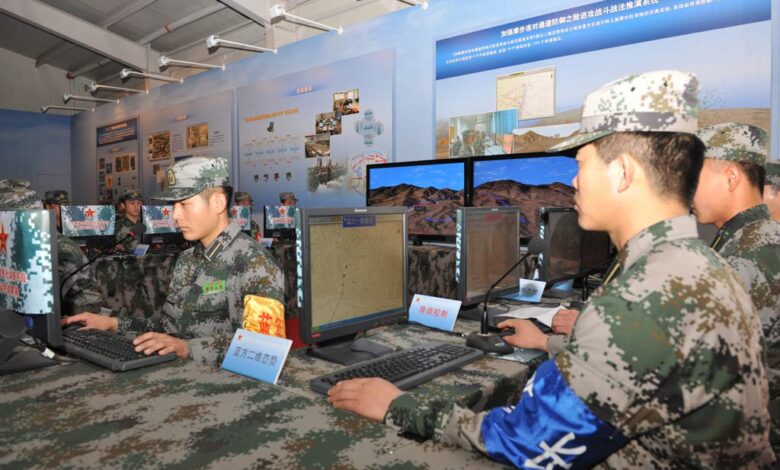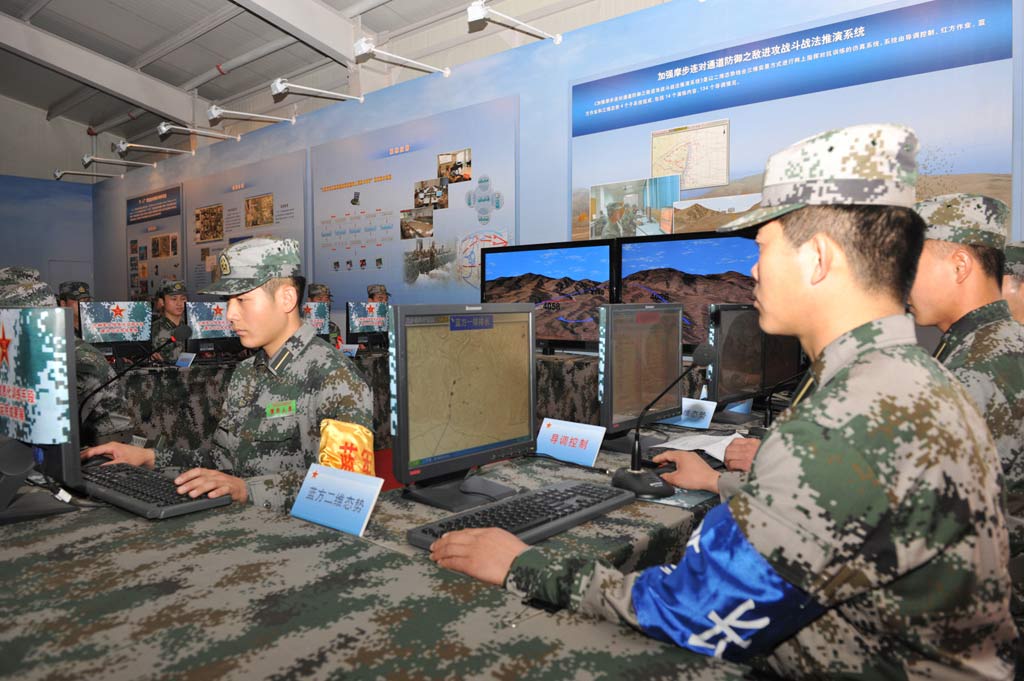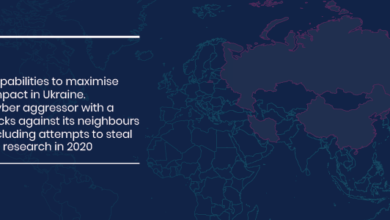
China Has 50 Hackers Against Each FBI Cyber Warrior
China has 50 hackers against each FBI cyber warrior – that’s the shocking claim swirling around the digital battlefield. Is it hyperbole, a realistic assessment, or somewhere in between? This deep dive explores the shadowy world of cyber warfare, pitting the alleged might of China’s digital army against the resources and strategies of the FBI. We’ll examine the evidence, analyze the capabilities of both sides, and consider the far-reaching geopolitical implications of this potential imbalance of power.
Get ready for a fascinating look into the hidden war raging online.
The claim itself originates from a confluence of factors: publicly available information about Chinese cyber operations, leaked intelligence reports, and analyses of successful attacks attributed to Chinese state-sponsored groups. We’ll examine the methodologies used to arrive at the 50:1 ratio, acknowledging the inherent difficulties in obtaining precise figures in this clandestine arena. This involves comparing publicly available data on the size and scope of China’s cyber forces with estimates of the FBI’s cyber workforce and budget.
We’ll also delve into the types of cyberattacks China is known to employ, from espionage and intellectual property theft to more disruptive attacks targeting critical infrastructure. Finally, we’ll look at the FBI’s defensive strategies and how effectively they counter these threats.
The Claim’s Context and Validity
The claim that “China has 50 hackers for every FBI cyber warrior” is a provocative statement circulating in online discussions and certain media outlets. Its origin is difficult to pinpoint precisely, likely stemming from a combination of anecdotal evidence, extrapolated data, and potentially deliberate exaggeration to emphasize the perceived threat of Chinese cyber capabilities. The validity of the numerical ratio, however, is highly questionable and lacks robust empirical support.
While China undeniably possesses significant cyber capabilities, a precise quantitative comparison with FBI resources is exceedingly complex and susceptible to significant inaccuracies.The claim’s context is rooted in the widely acknowledged reality of substantial Chinese state-sponsored cyber activity. This activity ranges from intellectual property theft targeting businesses and universities to espionage against government agencies and disruptive attacks against critical infrastructure.
Attributing specific attacks to China with absolute certainty is challenging, given the sophisticated techniques used to obscure origins, but there’s a considerable body of evidence pointing to Chinese actors.
Examples of Cyberattacks Attributed to Chinese Actors
Numerous reports from cybersecurity firms and government agencies document cyberattacks attributed to Chinese state-sponsored groups. For example, the 2014 attack on Anthem, a major US health insurer, resulted in the theft of personal data for millions of individuals, with strong indications pointing towards Chinese actors. Similarly, the persistent targeting of US defense contractors and technology companies by advanced persistent threats (APTs) like APT10 and APT41 has been extensively documented, showcasing China’s capacity for long-term, sophisticated cyber espionage.
These attacks, while not definitively quantifiable in terms of attacker-to-defender ratio, demonstrate the scale and sophistication of Chinese cyber operations.
Evidence Regarding the Numerical Claim’s Accuracy
The claim of a 50:1 ratio lacks credible supporting evidence. Estimating the number of Chinese hackers is inherently difficult, as it involves identifying and counting individuals operating within a clandestine and decentralized network. Similarly, the exact number of FBI cyber personnel is not publicly disclosed for security reasons. Any attempt to establish a numerical ratio between these two unknown quantities would rely on highly speculative assumptions and likely lead to significant overestimation.
While intelligence agencies may possess internal estimates, these are not publicly available and their methodologies are confidential.
Methodologies Used to Estimate the Ratio
The methodology behind the 50:1 ratio is likely based on extrapolating from publicly available data on Chinese cyber activity (e.g., number of reported incidents, number of APT groups identified) and comparing it to publicly available information (or educated guesses) about FBI cyber workforce size. This method is inherently flawed due to the significant underreporting of cyber incidents, the difficulty in attributing attacks definitively, and the lack of transparency surrounding the size and capabilities of both Chinese and FBI cyber teams.
The resulting ratio is therefore likely a gross oversimplification, possibly influenced by biases towards emphasizing the threat posed by China.
Comparison of Chinese Cyber Capabilities and FBI Cyber Resources, China has 50 hackers against each fbi cyber warrior
| Metric | China | FBI | Notes |
|---|---|---|---|
| Estimated Number of Cyber Personnel | Unknown, but likely in the tens of thousands | Unknown, but significantly smaller than China’s | Both figures are estimates based on various reports and are not officially confirmed. |
| Number of Reported Cyberattacks (Annually) | High, but exact figures are unavailable and often underreported. | Data not publicly available; focuses on investigations and remediation. | Attributing attacks to specific actors is challenging and often takes considerable time and resources. |
| Level of Sophistication | High, with evidence of advanced persistent threats and sophisticated techniques. | High, with access to advanced technologies and intelligence. | Both sides possess highly skilled personnel and advanced tools. |
| Resources | Vast state-sponsored resources available. | Significant resources, but limited compared to China’s state-sponsored capabilities. | The difference in resources available to both sides is a major factor in the perceived imbalance. |
Analyzing Chinese Cyber Capabilities

Understanding the capabilities of Chinese state-sponsored hacking groups is crucial for assessing global cybersecurity risks. These groups operate with sophisticated techniques, significant resources, and a clear strategic focus, posing a considerable threat to both governments and private entities worldwide. Their actions range from espionage and intellectual property theft to disruptive attacks against critical infrastructure.
Structure and Organization of Chinese State-Sponsored Hacking Groups
The organizational structure of Chinese state-sponsored hacking groups is complex and often opaque. While not publicly acknowledged by the Chinese government, evidence suggests a decentralized model, with various groups operating under different ministries and agencies, potentially including the Ministry of State Security (MSS), the People’s Liberation Army (PLA), and various intelligence agencies. These groups may collaborate on large-scale operations or operate independently, depending on the specific target and objectives.
The lack of transparency makes definitive statements about their hierarchical structure challenging. However, it’s widely believed that coordination and oversight from higher levels exist to ensure alignment with national strategic goals.
Types of Cyberattacks Employed by Chinese Actors
Chinese state-sponsored actors employ a wide range of cyberattacks. Espionage is a primary focus, targeting sensitive government information, military secrets, and technological advancements. Intellectual property theft is another significant area, aimed at stealing trade secrets and competitive advantages from businesses in various sectors, including technology, pharmaceuticals, and manufacturing. Infrastructure attacks, while less frequent, have been observed, targeting critical systems and causing disruptions to essential services.
These attacks often employ advanced persistent threats (APTs) to maintain long-term access to compromised systems.
Technological Tools and Techniques Used by Chinese Hackers
Chinese hackers are known for their proficiency in exploiting vulnerabilities, developing custom malware, and using advanced techniques to evade detection. They leverage sophisticated tools for reconnaissance, exploitation, and data exfiltration. Custom-developed malware allows for tailored attacks and avoids detection by standard antivirus software. Techniques like spear phishing, watering hole attacks, and zero-day exploits are frequently employed to gain initial access to target systems.
The use of proxy servers and virtual private networks (VPNs) helps to mask their origins and hinder attribution.
Comparison of Chinese TTPs with Other Nation-State Actors
While the TTPs employed by Chinese hackers share some similarities with those used by other nation-state actors (such as Russia and North Korea), there are also key distinctions. Chinese actors often exhibit a greater focus on long-term espionage and intellectual property theft, while some other actors may prioritize disruption or sabotage. The scale and sophistication of Chinese operations are also notable, reflecting significant investment in cyber capabilities.
However, all nation-state actors adapt their tactics based on evolving technological landscapes and geopolitical objectives. A comparative analysis requires a detailed examination of specific campaigns and attributed actions.
Key Characteristics of Chinese Cyber Operations
The following points highlight key characteristics of Chinese cyber operations:
- Focus on Espionage and IP Theft: A significant portion of their activity centers around stealing sensitive information and intellectual property.
- Sophisticated Techniques and Tools: They utilize advanced malware, exploit zero-day vulnerabilities, and employ advanced evasion techniques.
- Long-Term Campaigns (APTs): Many operations involve persistent access to target systems over extended periods.
- State Sponsorship: These operations are widely believed to be directed or supported by the Chinese government.
- Global Reach: Their targets span various countries and sectors, demonstrating a broad operational scope.
- Operational Secrecy: Attribution is often difficult due to the use of sophisticated techniques and proxies.
Assessing FBI Cyber Defense Strategies

The FBI’s role in combating cyber threats, particularly those originating from China, is multifaceted and crucial to national security. Understanding their organizational structure, resources, and strategies is vital to assessing the effectiveness of US cyber defense against sophisticated state-sponsored attacks. This analysis focuses on the FBI’s capabilities and how they are deployed to counter Chinese cyber operations.
FBI Cybercrime Division Structure and Resources
The FBI’s Cybercrime Division is the primary unit responsible for investigating and combating cybercrime, including attacks from foreign entities like China. It possesses a substantial workforce comprising agents, analysts, and technical specialists with diverse expertise in areas such as network security, malware analysis, and digital forensics. The division leverages significant budgetary resources to acquire cutting-edge technologies, develop specialized training programs, and foster collaborations with both public and private sector partners.
The exact figures for personnel and budget are classified for national security reasons, but it’s understood that significant investments are made to maintain a robust cyber defense posture.
FBI Strategies for Detecting, Preventing, and Responding to Chinese Cyberattacks
The FBI employs a multi-pronged approach to counter Chinese cyberattacks. Proactive measures include threat intelligence gathering, vulnerability assessments, and the development of preventative measures shared with critical infrastructure organizations. Reactive strategies focus on incident response, digital forensics, and the pursuit of legal action against perpetrators. This involves close collaboration with private sector companies affected by attacks, facilitating information sharing and coordinated response efforts.
The FBI also works internationally to share intelligence and coordinate law enforcement actions against Chinese cyber actors. A key element is attribution – identifying the perpetrators with sufficient evidence to pursue legal or diplomatic action.
Key Technologies and Partnerships in FBI Cyber Defense
The FBI utilizes a range of advanced technologies in its cyber defense efforts. This includes sophisticated network monitoring tools for early threat detection, malware analysis platforms for dissecting malicious code, and data analytics capabilities for identifying patterns and predicting future attacks. Critical partnerships are forged with private sector cybersecurity firms, sharing threat intelligence and collaborating on incident response.
International collaborations with allied intelligence agencies are also vital, allowing for the pooling of resources and expertise to combat transnational cyber threats. These partnerships often involve sharing information about malicious actors, attack techniques, and vulnerabilities.
Comparison of FBI Cyber Capabilities with Other Intelligence Agencies
Comparing the FBI’s cyber capabilities to other US intelligence agencies requires acknowledging the differences in their mandates and operational focus. The NSA, for instance, focuses heavily on signals intelligence and foreign cyber espionage, while the CIA concentrates on human intelligence and covert operations. The FBI, in contrast, prioritizes law enforcement and criminal investigations in cyberspace. While each agency possesses unique strengths, they often collaborate to address complex cyber threats.
Information sharing and joint operations are common, ensuring a coordinated national response to sophisticated attacks. The FBI’s expertise in digital forensics and criminal prosecution complements the intelligence-gathering capabilities of other agencies.
Intelligence Gathering and Analysis to Counter Chinese Cyber Threats
The FBI utilizes a wide range of intelligence gathering methods to counter Chinese cyber threats. This includes open-source intelligence (OSINT), signals intelligence (SIGINT) shared with partner agencies, and human intelligence (HUMINT). Sophisticated data analytics techniques are used to sift through vast quantities of data, identifying patterns and indicators of compromise (IOCs) that reveal malicious activity. This intelligence is then used to inform proactive security measures, guide investigations, and support legal actions against Chinese cyber actors.
The analysis helps to understand the motives, tactics, and capabilities of Chinese cyber operations, enabling the development of effective countermeasures.
The Broader Geopolitical Implications
The purported 50:1 ratio of Chinese hackers to FBI cyber warriors, even if not precisely accurate, highlights a significant imbalance in cyber capabilities with far-reaching geopolitical consequences. This asymmetry impacts US national security, economic interests, and the global landscape of cybersecurity cooperation. Understanding these implications is crucial for developing effective countermeasures and fostering international collaboration.The claimed imbalance underscores a considerable threat to US national security.
Successful Chinese cyber operations could compromise critical infrastructure, steal sensitive government data, disrupt military communications, and even influence elections. The potential for large-scale attacks targeting power grids, financial institutions, or defense systems presents a serious and ongoing challenge. This necessitates a multi-pronged approach to national security, including robust defensive measures, proactive intelligence gathering, and effective deterrence strategies.
Impact on US Economic Interests
Chinese cyber activity significantly impacts US economic interests. Intellectual property theft, a recurring theme in cyber espionage, costs US businesses billions of dollars annually. This theft includes everything from trade secrets and technological innovations to research and development data, giving Chinese companies an unfair competitive advantage. Furthermore, cyberattacks targeting financial institutions can lead to significant financial losses and erode consumer confidence.
The disruption of supply chains through cyberattacks also creates economic instability and hampers economic growth. For example, the 2017 NotPetya ransomware attack, while not directly attributed to China, highlighted the potential for widespread economic damage from large-scale cyber incidents. The global disruption cost billions, impacting businesses and consumers worldwide.
International Cooperation in Addressing Cyber Threats
International cooperation is essential in addressing the challenge posed by Chinese cyber activities. No single nation can effectively combat sophisticated cyber threats alone. Sharing threat intelligence, coordinating defensive strategies, and developing international norms of responsible state behavior in cyberspace are crucial steps. However, achieving effective international cooperation faces significant obstacles, including differing national interests, legal frameworks, and levels of technological capabilities.
The creation of effective international mechanisms for attribution and accountability for state-sponsored cyberattacks remains a key challenge.
Comparative Responses to Chinese Cyber Activities
Different countries have adopted varying responses to Chinese cyber activities. Some nations, particularly those with strong alliances with the US, have publicly condemned Chinese actions and implemented sanctions. Others, prioritizing economic ties with China, have adopted a more cautious approach, often refraining from direct confrontation. The European Union, for example, has attempted to strike a balance between addressing security concerns and maintaining economic relations with China.
This divergence in responses reflects the complex geopolitical considerations involved and the lack of a unified global approach to cyber warfare.
Timeline of Significant Cyber Incidents Attributed to China
The following timeline presents a selection of significant cyber incidents attributed to China, illustrating the evolution of their cyber capabilities and the responses they have elicited. Note that attribution in cyberattacks is inherently complex and often difficult to definitively establish.
The sheer scale of China’s cyber warfare capabilities, with reports suggesting a 50:1 hacker-to-FBI-agent ratio, is truly alarming. This highlights the urgent need for robust, rapidly deployable security solutions. Learning about efficient app development, like exploring the possibilities outlined in this article on domino app dev the low code and pro code future , could help bridge the gap in defensive capabilities against such overwhelming odds.
Ultimately, strengthening our digital defenses is crucial in this ongoing cyber arms race with China.
- 2009-2010: Multiple attacks targeting Google and other US companies, alleged to be state-sponsored, led to increased awareness of Chinese cyber espionage.
- 2012: The indictment of five Chinese military officers by the US Department of Justice marked a significant escalation in the US response to Chinese cyber activities.
- 2014-2015: A series of attacks targeting US government agencies and businesses highlighted the ongoing threat of Chinese cyber espionage and the limitations of existing defensive measures.
- 2017: The NotPetya ransomware attack, while not directly attributed to China, demonstrated the potential for devastating global economic consequences from large-scale cyber incidents.
- Ongoing: Continued reports of intellectual property theft, targeting of critical infrastructure, and attempts to influence elections highlight the persistent nature of the threat.
Illustrative Scenarios
Let’s explore some hypothetical scenarios to illustrate the potential consequences of a large-scale cyberattack originating from China targeting critical US infrastructure. These scenarios are based on existing vulnerabilities and observed Chinese cyber capabilities, aiming to highlight the gravity of the threat.A hypothetical scenario involves a coordinated attack targeting the US power grid. This wouldn’t be a simple outage; rather, a sophisticated campaign designed to cause cascading failures across multiple states.
A Coordinated Attack on the US Power Grid
Imagine a scenario where Chinese state-sponsored hackers infiltrate multiple control systems within the US power grid over several months. They achieve this through a combination of spear-phishing attacks against utility employees, exploiting known vulnerabilities in outdated software, and leveraging compromised IoT devices. The attackers remain undetected, gradually gaining control of critical infrastructure components. Then, on a chosen day, they execute a synchronized attack, disabling key substations and triggering widespread blackouts across several states.
Potential Consequences of the Power Grid Attack
The consequences would be devastating. The immediate impact would be widespread power outages, affecting millions of people. Hospitals would lose power, impacting patient care and potentially leading to fatalities. Financial institutions would be crippled, halting transactions and causing significant economic losses. Transportation systems, including trains and air travel, would be severely disrupted.
The resulting social unrest and economic disruption could be immense, with long-term consequences for the US economy and national security. The cost of recovery and rebuilding could reach hundreds of billions of dollars, stretching over years. Furthermore, the loss of public trust in the nation’s critical infrastructure would be substantial.
Challenges in Investigating and Prosecuting Chinese Cybercriminals
Investigating and prosecuting Chinese cybercriminals presents unique challenges. The geographical distance and lack of direct legal cooperation between the US and China make it extremely difficult to gather evidence and bring perpetrators to justice. Often, the attackers operate from within China, shielded by its government’s policies and lack of transparency. Even when evidence is gathered, extraditing suspects is nearly impossible.
Furthermore, the complex nature of cyberattacks, involving intricate obfuscation techniques and the use of proxy servers, adds further complexity to investigations. This lack of accountability encourages further attacks.
FBI Response Plan to a Significant Cyberattack
The FBI’s response would involve a multi-pronged approach. First, they would focus on containing the attack, limiting its spread and mitigating further damage to critical infrastructure. This would involve coordinating with private sector companies and other government agencies. Secondly, the FBI’s cybercrime division would launch a comprehensive investigation to identify the perpetrators, trace their actions, and gather evidence for potential prosecution.
This would involve collaborating with international partners and leveraging advanced forensic techniques. Thirdly, the FBI would work to restore affected systems and infrastructure, coordinating with industry experts and providing support to victims. Finally, the agency would engage in proactive measures to prevent future attacks, including improving cybersecurity defenses and enhancing intelligence gathering.
So, the stat’s out there: China reportedly has 50 hackers for every FBI cyber warrior. That’s a massive disparity, highlighting the urgent need for robust cybersecurity solutions. Understanding how to effectively manage cloud security is crucial, which is why I’ve been researching bitglass and the rise of cloud security posture management – it’s a game changer in this landscape.
Ultimately, strengthening our defenses against such overwhelming odds requires innovative tools and strategies, and that includes prioritizing cloud security. The sheer number of Chinese hackers makes this more than just a suggestion.
Visual Representation of a Cyberattack
Imagine a diagram. On the left, we see a server farm in China, labeled “Chinese Cyber Operations Center.” From this center, numerous lines representing data streams extend across the Pacific Ocean. These lines converge on a small node labeled “Compromised IoT Device” within a US city. From this device, further lines branch out, reaching nodes representing a power substation’s control system.
Arrows indicate the direction of the attack’s progression. The final node shows the power substation, with a red “X” indicating a disruption of power. The entire diagram illustrates the journey of the malicious code, from its origin in China to its impact on the US power grid.
Final Thoughts
The alleged 50:1 ratio of Chinese hackers to FBI cyber warriors paints a stark picture of the challenges facing US national security in cyberspace. While the exact numbers remain debated, the sheer scale of Chinese cyber activity is undeniable. The implications are vast, extending beyond simple data breaches to encompass economic espionage, disruption of critical infrastructure, and the erosion of national trust.
Ultimately, this “cyber arms race” necessitates international cooperation and a robust, adaptable defense strategy from the US and its allies. The fight for digital dominance is far from over, and the stakes continue to rise with every keystroke.
Expert Answers: China Has 50 Hackers Against Each Fbi Cyber Warrior
What specific evidence supports the 50:1 claim?
There’s no single, definitive piece of evidence confirming the exact 50:1 ratio. The claim is based on a combination of reported incidents, analyses of Chinese cyber capabilities, and estimates of FBI resources. The lack of transparency on both sides makes precise quantification extremely difficult.
How does China’s cyber strategy differ from other nation-states?
China’s cyber operations are often characterized by their scale, sophistication, and close ties to the government. While other countries engage in cyber espionage and attacks, China’s operations are often seen as more focused on long-term strategic goals, including economic gain and technological advancement.
What are the biggest challenges for the FBI in combating Chinese cyber threats?
Challenges include the sheer volume of attacks, the difficulty of attribution (proving who is responsible), jurisdictional issues, and the need for international cooperation to effectively counter state-sponsored hacking groups.
What role does international cooperation play in addressing this issue?
International cooperation is crucial for sharing intelligence, developing common standards, and coordinating responses to transnational cyber threats. However, differing national interests and a lack of trust can hinder effective collaboration.





